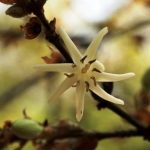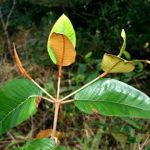TREE LIFE
AUGUST 1991
MASHONALAND CALENDAR
Saturday, 3rd August: Botanic Garden Walk with Tom Muller at 1045 hours for 1100 hours. Park your car at the Herbarium.
August 9 – 12: Chimmanimani
Sunday 15th August: A recce to Tsindi Ruins revealed that many trees have done what they normally do at this time of year, shed their leaves. An alternative venue has kindly been offered by Mr. Geoff Hawksley who owns Rocky Mountain Farm in the Concession area. The farm has a river, some dams and a waterfall as well as several different soil types – what could be better. Shall we find Syzygium cordatum, Ilex mitis, Apodytes dimidiata, Maesa lanceolata, Mimusops zeyheri, Chionanthus battiscombei, Acokanthera oppositifolia, Olea europaea and Dalbergia melanoxylon ? Quite possibly.
Thursday 3rd September: Summer is back and so we revert to our Botanic Garden walks on Tuesday afternoons at 1645 hours for 1700 hours.
MATABELELAND CALENDAR
Sunday 4th August l99l: To Dr. Gelmans farm at Heany Junction – he will be joining us. 24 km of tar (Harare road) and 12 km of normal gravel road. On a recent recce, the aloes were flowering along the gravel road – quite a sight. An all-day outing – bring teatime/lunchtime/chairs, and meet at Ascot Car Park (lifts already arranged) at 0830 hours.
NOTE AN EXTRA — SATURDAY 17th August 1991: I know the extras are not as popular, but the new owner of “Broadleas” (just beyond Matopos Mission, eastern Matopos) – Mike Paul, is so keen for us to identify his trees that this is a must. Another all day – bring lunch/chairs, and meet at Retreat at 0830 hours. After about 49 km on the Old Gwanda Road we will regroup at the Quaringa Road turn off — and an easy 4 km from there.
Wednesday, 21st August 1991: McHEW – Hillside Dams at 5.00 pm.
Sunday lst September 1991: Back to Bambata Cave area where we had so much success before – we have to exceed 8l species. Meet at Retreat at 0830 hours.
MATABELELAND BRANCH : KLOOF FARM, PASIPAS – SUNDAY 7TH JULY
This was the day of the great returns! An only slightly subdued Charles returned for his first day-outing after his convalescence and it was great to have him with us again. Wendy was there after a long absence and led the “valley” brigade of Cecily and Daphne, both returned after accidents, and they added useful observations to our list.
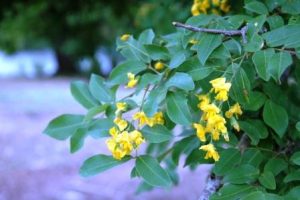
Pterocarpus lucens. Photo: Chris McBride. Source: Flora of Zimbabwe
Ian, always on the alert for Ficus species, found F. thonningii growing out of the enormous Albizia amara that we all parked under. Then the first problem of the morning was encountered, which after lengthy discussions turned out to be Pterocarpus lucens, only recognised before by its magnificent yellow flowers this time of course, it wasn’t so kind!
Most of us staggered up the hill “pausing” to observe variously, Bridelia mollis, Cassine matabelica, Albizia antunesiana, Azanza garckeana (the gland on the back of the leaf always a good talking point) Dombeya rotundifolia (a good comparison to the previous one), Commiphora mollis with its flattened trunk and the Grewia flavescens with its squared branches, leading to the G. monticola with smooth leaves and no square trunk, Pappea capensis likened to holly leaves but only when young as with the very toothed leaf-edge of the Cassine transvaalensis also mainly when young.
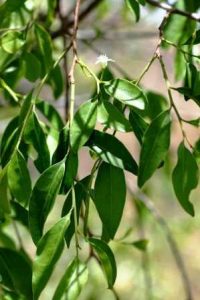
0lax dissitiflora. Photo: Bart Wursten. Source: Flora of Zimbabwe
A great talking point were the ginormous leaves of a very small (and young) Erythrina latissima showing the thorns stuck out top and bottom of the leaves, presumably as protection against browsing animals. Eileen (and Ian also back from long leave) was so sure that I would ask her about “the” tree, so that when I called out “Eileen”, back came the reply from 50 yards away “0zoroa” A tree that brought together “G4” (a group of Geoff, Charles, Ian and Betty) was only resolved with Maureen’s help in Harare (Thank you) a completely out-of-place (and new one of us) 0lax dissitiflora on top of a rocky hill, instead of along a river course. “G4” were also called upon to solve the Acacia mysteries – fleckii, gerrardii, karroo, nilotica (which Geoff says has the thorns facing backwards), Commiphora schimperi (completely leafless) Dalbergia melanoxylon, Euclea racemosa, Maytenus heterophylla, Pavetta schumanniana a truce was called on this one between Geoff and Charles), Turraea nilotica and the beautiful maroon leaved Terminalia randii. But great friends, like Ormocarpum trichocarpum (Kens hairy caterpillar pod) , Peltophorum africanum, Pseudolachnostylis maprouneifolia (Jill’s new tree), Gardenia volkensii, Flueggea virosa (sadly at this time, the misnamed snowberry), Euclea divinorum (Margaret’s tree), Euphorbia ingens, and unexpectedly, some large Colophospermum mopane, helped the not so knowledgeable to add their own ticks to the card.
Back on ground level again, we added (with Mandy’s help) Parinari curatellifolia, Acacia erioloba, a beautifully knobbly A. nigrescens, Cassia abbreviata (with some long pods still adhering), Diplorhynchus condylocarpon (not happy to show its latex), Lannea discolor, Pterocarpus angolensis some trees absolutely loaded with the Fried egg pods), Sclerocarya birrea, Ziziphus mucronata, and across the road in the Kalahari sand, Baikiaea plurijuga, (teak).
After tea, we decided to investigate the Combretum species, and came up with some wonderful pod samples of C. collinum (very variable), C. hereroense, C. imberbe and the enormous C. zeyheri. A fitting end to a beautiful morning outing in wonderful weather.
Little did I know when writing the calendar, how true was the expression, “Stumble along” the kopje — it was so unexpectedly full of round basalt rocks-(particularly when trying to admire the view) – but no injuries, luckily! Anne Visser’s part of Pasipas is a really exciting area, is easily accessible and still has some surprises left for us in the future.
MCHEW – 17th July 1991
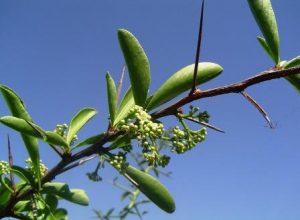
Maytenus heterophylla. Photo: Bart Wursten. Source: Flora of Zimbabwe
Ian finds the months come round too fast, and his hair is noticeably greyer, trying to think up themes for this popular outing. This month was “leathery leaves” (with the expected photocopies) and particularly, members of the CELASTRAEAE family, represented by Maytenus heterophylla, M. senegalensis, M. undata (with its powdery leaves), Cassine matabelica and C. transvsaalensis.
The weather was cold and most unkind, out we were warmed by the “hot air” generated by Charles, Geoff and Ian in solving the many CELASTRACEAE puzzles. Thank you Ian, for another very entertaining Mchew!
PS — Being a stamp collector, I was rather delighted with the recent very topical (for us) issue of the “wild Fruits of Zimbabwe” – and would like to congratulate Barbara Chalk (wherever she is!) for the wonderful designs.
-KEN BLAKE
KYLE FARM – MUTOROSHANGA
As we headed northward through Mazowe to the Hatley’s farm, I just knew we would arrive at emerald green lawns with a sumptuous tea. I wasn’t wrong. Their farm is on the Umvimele Dyke, maybe this needs explanation. We all know about the Great Dyke which forms a long scar of serpentine rock down the centre of the country. Well, just a few kilometres away on each side of the Great Dyke, there is a parallel dyke of dolorite. Most of the time this dolorite has weathered down to the same level as the surrounding granites and gneisses so it is not easily seen. But along the west side of the Dyke, to the north of the Kariba road the dolorite forms a range of hills called the Umvimele Dyke. I don’t know a lot about dolorite, but generally igneous rocks (which were formed by solidifying magma) consist of three minerals, quartz (translucent crystals), feldspar (white opaque crystals) and micas (the darker parts of the rock, different types of mica occur). The faster the rock cools down the smaller these crystals are, if the rock cools down slowly there is lots of time for large crystals to form. I first learnt about granites on Clifton beach many years ago, and these all have large crystals. Dolorites are different to granites because the crystals are smaller (they cooled faster) and there is more mica (so they are darker in colour). Related to their being darker is the fact that they may have more iron in them, and as iron rusts it turns red, so the soils associated with the dolorite is sometimes redder. We saw all of these features next to the Umvimele Dyke.
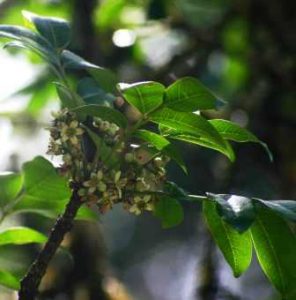
Ekebergia capensis. Photo: Bart Wursten. Source: Flora of Zimbabwe
The first tree we found presented a problem. It had large furry compound leaves that were both paripinnate and imparipinnate. Despite attempts to call it Zanha I remained unconvinced, particularly as we saw later looking like what Zanha should. There was no ball and claw, and this feature usually shows up well in the dry season. In addition the leaf margin was too entire and the imparipinnate leaves looked too real (Zanha only has imparipinnate leaves when one leaflet aborts, these false imparipinnate leaves are fairly distinctive). The herbarium decided it was Ekebergia capensis. On the drive out from the farm we found a typical Ekebergia capensis at the entrance to another farm, but in this case the leaves were completely smooth.
The dolorite dyke had a number of puzzles to get the brains moving: Strychnos potatorum with no leaves but covered in brown berries; Sterculia quinqueloba without leaves but lots of fruit; Dalbergia melanoxylon with its spiny branches, both species of Uapaca growing next to each other; Hexalobus monopetalus, which we don’t have around Harare; and Pterocarpus rotundifolius subsp. polyanthus var antunesii or something equally ostentatious, (like martinii Ed.). Ormocarpum kirkii covered in dried flowers; large Afzelia quanzensis in pod; and magnificent Commiphora marlothii.
Another exciting find was Triaspis macropteron, which Dickie Graves recognised. It looked like a woody shrub to 2 metres, but with some branches forming tendrils. It initially appears to have an interpetiolar stipule — but close examination shows two stipules on each side of the branchlet. Otherwise does look like it belongs to the RUBIACEAE – although it does not – it is really in the MALPIGIACEAE.
From this rocky hillside some of us walked to the lunch site and found a wealth of interesting species: Brachyleana rotundata stands out as being particularly unusual, but there was also Pappea capensis, large specimens of Gardenia ternifolia, Ficus sur and F. thonningij, Tarenna neurophylla and Apodytes dimidiata.
Although the nights have been so cold lately, the glorious sunshine warmed us up over lunch before we set out to examine a nearby granite rock. Here we found fine specimens of Ficus ingens and F. glumosa, the latter with two large hammerkop nests in the branches. Both of these species are fairly rare around Harare. Many of the exciting finds of the day are related to lower altitude relative to Harare.
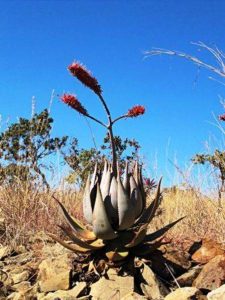
Aloe ortholopha. Photo: Isla Grundy. Source: Flora of Zimbabwe
After yet another superb tea Anne escorted some of us to a patch of Aloe ortholopha on the Caesar Mine Pass. This Pass has superb vegetation along its stream, but these aloes were looking particularly spectacular this month, with their spikes of flowers set off horizontally. This species is restricted to serpentine soils of the Great Dyke. Some of us may recall our last fatefull trip to the Hatley’s farm when we destroyed the bus gearbox on Caesar Mine Bus, we eventually returned and used Mutoroshanga Pass, but by then the damage was done and the bus driver realized he could not change down while we were heading down a steep slope that ended in a narrow bridge. Fortunately he managed to pull to the side and Tree Society members were entertained by the trees in the area till well after dark when a new bus arrived from town.
We are all grateful to the Hatleys for allowing us to invade their farm again, it really does have interesting vegetation. And thanks for the tea. For those of you who missed the notice in the paper, Cecile and I are now engaged. Isn’t that a surprise to all who thought I was destined to play the field forever!
-Kim Damstra
SOOTY MOULD ON BAOBABS IN ZIMBABWE
I have recently travelled to the wild places around Zimbabwe and was shattered at the extent to which the Baobab trees within the areas visited have been affected by a black, sooty-like disease.
This disease has been recorded before in the early 1980s. The identification of the Fungus responsible has not yet been confirmed though two names have been suggested by authorities. It is suspected to be a sooty mould and manifests itself in the following ways:-
1 Early Stages — circular, waxy patches, reddish—brown becoming black; at first glance could be mistaken for lichen growth.
2 Mid to Late Stages – extensive blackening of branchlets and/or branches and/or trunk; coalescing of black pustules into a sooty mass.
3 Extreme Stage — blackened, weeping branches which drop off easily; defoliation apparent, and chronically ill appearance, (takes on the appearance of having been totally burnt in a bad bushfire).
The disease would appear, from casual observation, to be found predominantly on the lee side of the tree. No particular age group of tree would appear to be more susceptible than another. Although drought could possibly be the main catalyst in the rapid degeneration of Zimbabwe’s baobab population; this needs to be substantiated, and other potential causative factors examined.
I am preparing a paper with Geoff Calvert of Forestry Commission on this subject. We would appreciate any observations / previous knowledge / records / photographs etc. that you may have that would assist in the investigation of the problem, particularly with regard to rates of infection etc. Historical photos of trees in known locations would be especially valuable. Geoff initiated a similar request through the Editor of Zimbabwe Science News 23, 1/3 1989, but only received one response. This matter is of national importance and your cooperation would be gratefully appreciated. Due acknowledgment will be given for any contributions used in the published article.
I invite comment from you on the matter and respectfully request your consideration of my request. MRS CATHY SHARP. P.O. Box 100, MVUMA, ZIMBABWE
NYARUPINDA CATCHMENT – JULY 1991
Natures Spectacular. June was memorable for the celestial phenomenon of the planets hobnobbing with the moon. Venus, Mars and Jupiter were closer to the earth than at any time since December 23rd 1769. This was clearly seen in the winter sky over Zimbabwe. It is winter now and then; hot, cold and sometimes cloudy and humid, treacherous weather. Have you noticed that some trees and shrubs grow strongly in the cooler months e.g. Uapaca nitida, Maytenus senegalensis and Maerua juncea alongside Cadaba termitaria on the termite mounds.
With reference to last months “Tree Life” the verity and eloquence of Dick Petheram’s appreciation of Jack and Judy Reid evoked a tear. Their thoughts about the countryside, “they never took it for granted; it was always new and always fascinating.” People who share these sentiments will understand why it is difficult for me to end this series of notes; because there is always something to tell you.
How lucky to find Sundew. These and other insectivorous plants are, by their mode of nutrition, able to survive in soils deficient in available nitrogen. Droseras hideout in the catchment is yet to be found, maybe in seepage or in water-filled basins in rocks.
The Ecological Tapestry will be enlarged to cushion size, a square 36cm x 36cm.
RAFFINGORA KOPJE: 14 June 1991
This was an O.P. during the civil war, the all round view shows the Great Dyke (East), Banket (South), Manyame range of hills to the west obscuring Tengwe, Doma mountain (North). The route to this kopje made us aware of altitudes, because of the occurrence of escarpment Brachystegia – B. allehii, MTURU in the vernacular language. This species is more widespread than is shown on the map on p.270 in “Trees of Southern Africa” 1977 edition. This kopje is at the top edge of the Raffingora map, in the vicinity of the Musongwa tributary of the Manyame. There was not water in this place, we noted the absence of fig trees. Progress was easy amongst sparse vegetation on a stony slope. where the altitude was approximately 1140 metres (3400ft. above sea level) Brachystegia boehmii was replaced by B. allenii. This abrupt transition is ecologically important. There is no mistaking the grey—green different foliage and the smaller stature of this species.
The following species were found on the top of the kopje: Brachystegia glaucescens, Bridelia cathartica, Cussonia arborea, Faurea saligna (a surprise) Lonchocarpus capassa, Psydrax livida, Pterocarpus angolensis and Strychnos innocua. There was a panel of rock art on which the writer was asked to comment whilst being videoed. This was a stop; go experience as the camera found the baboons; the hunter holding bow and string both bent; an empty quiver; some antelopes and a little apart a degenerate human figure who seemed to look at the beautiful frieze, fortunately this person was not my escort.
LONG CRESTED EAGLE AND SAINT JOHNS WORT.
The Evangelist John is symbolised by an eagle. On July 5th a long crested Eagle watched for prey in a moist vlei where Hypericum roeperianum is coming into flower. This happened on the day we remembered to change the pictorial calendar to July — a long crested Eagle.
Mr. H M Biegel, a keen collection of indigenous plants, who wrote the text of “Rhodesian wild Flowers”, says that the name of the genus Hypericum comes from the Greek words above and pictures. This referred to an old custom of placing flowers above images of Saint John on his feast day to ward off evil. There is a legend that the devil took revenge, he stabbed the leaves with a needle. Handlens inspection of the plant shows that he also left a trail of black spoor on the margins of the leaves and a scattering on the petals. Hypericum roeperianum has tiny translucent dots in the leaves and there are black glands on the leaf margins and on the petals, what a revelation! Unfortunately the shorter, twiggy, cultivated species lack the black markings, thus there is an obligation to find the wild one whilst it is in bloom.
BUAWAYO NATURAL HISTORY MUSEUM
Some fresh water sponges attached to grass stems found near the “Nyarupinda Dam” were sent to be identified. Mrs. Minshull will send these to a colleague who is more conversant with aquatic animals, she will let us know “as we learn more”. Two photos of a spider, web, egg cases and food were included in the packet, just to confirm their identity. This has proved to be another “teaser”, however, the spider is a species of orb weaver which has a golden web. These webs etc. were found in Brachystegia woodland near this house. The museum would like specimens of both male and female if they are found next rainy season.
Thanks to Mrs. Haxen for some feedback about the use of laticiferous plants – even if the fig latex did not cure the warts. Perhaps Choats Extract of Lettuce is successful in curing coughs, very topical just now.
PRICKLY PEAR and some LOCAL ORAL HISTORY
Opuntia megacantha cactus is an obnoxious exotic invader of Zimbabwe, they were introduced into arid places for fruit and stock feed. Prior to 1950, our neighbour, John Griffin Wilson began to open up land which he called Chapstow. At that time Africans told him that a policeman from Salisbury used to spend his leave living in the bush close to this small hill where we live. A clump of Prickly Pears marked his campsite. During the tobacco boom the area was cleared and ploughed it was then that the earth revealed three circles of different soil near the Opuntia-covered termite mound. Subsequently the writer found shards of pottery: some graphite burnished, some plain and some decorated with Refuge/Contemporary patterns. More interesting were bits of thick pale green glass and two different kinds of dark green glass…….. The hut circles suggest that this lone white man may have had two servants to look after him. They would have brought water from the Nyarupinda river close by, where their master caught fish. Fruit from riverine trees and some like Diospyros kirkii and Uapaca kirkiana in the dry woodland might have made a welcome change from Prickly Pears. To this day bush pig, porcupine, reedbuck, oribi and grey bush duiker are plentiful. Quail, francolin, guinea fowl and doves would have gone into the pot. On his return from the bush, mail awaited the policeman; some of it might have borne stamps of King George VI, Victoria Falls or perhaps the Mounted Pioneer. Stamps depicting a few “wild Fruits” would have appealed to him, he knew the best ones to eat, he was not concerned with their Latin names. Now, more or less fifty years later, their scientific names are catching on.
Here is a list of them: Azanza garckeana; Sclerocarya birrea subsp. caffra; Parinari curatellifolia; Syzygium cordatum; Friesodielsia obovata; Uapaca kirkiana.
Prompted by Jeff Huntly’s observations of Opuntia in his “Veld Sketchbook One”, the policeman’s camp site was revisited recently. It was approached unobtrusively so as to see whatever was there. Numerous paths made by weaner cattle were followed into the cactus thicket, what a strange eerie environment to us, out favoured by birds and snakes. A bird had nested in the luffa-like dried out cladodes which were piled one on top of the other. A portion of Opuntia luffa has been added to the botanical collection adorning the sable horns on the veranda.
-Benedicta Graves
The dreary subject of finance, or more correctly the lack of it in this age of rapid inflation, was discussed at the A.G.M. Donations were invited to see us through this year, and the response has been most pleasing. The Chairman and Committee would like to thank the following members for their support.
Mr. & Mrs. Bianchi, Mr. & Mrs Petheram, Mr. & Mrs. Haxen, Mrs. L Marsh, Ken & Betty Blake and Bulawayo members, Mr Bell, Mr. & Mrs. Lind and Geoff Archer. Anne and Mino Bianchi of P.O. Box 8, Chegutu will be very happy to make donations to the Society in return for good tree seeds. It is seed season right now, so gather, label and post some to Chegutu.
DEPRIVATIONS AND MEANINGS OF BOTANICAL NAMES OF SOME ZIMBABWEAN TREES
Introduction: Many laymen searching for knowledge of our indigenous trees, very soon come across a stumbling block : Understanding, remembering and digesting botanical names. The difficulty is compounded since many local trees have no common English name and African names, except for the well known handful are also difficult. African names, moreover, change according to the dialect spoken, one name often covers several species and one name can often be spelt three different ways.
English names likewise suffer from unreliability.
Thus we have the situation where our common “Pod Mahogany” (which has pods but is not a true mahogany) has a total of 13 different native and English names in Zimbabwe alone. In Mozambique, it boasts 23 names, in South Africa another 5. If it is the same tree, it has, on the other hand, only one scientific botanical name – AFZELIA QUANZENSIS, by which it is known in all three countries.
Every known plant has a set of botanical names by which it is known throughout the world. The two with which we are most usually concerned are the generic name (the “Surname”) and the specific name (the individual name). If two or more varieties have been distinguished, the varietal name is added. For the sake of completeness, the (usually abbreviated) name of the botanist who first named the plant is sometimes given and possibly also the herbarium number by which it may be identified positively.
This system of nomenclature was first envisaged by Casper Bauhin (1560 — l624) but was universally applied by the great Swedish naturist Linnaeus (1707 – 1773)-
CONGRATULATIONS TO KIM AND CECILE – WE ALL WISH YOU GREAT HAPPINESS
KIM DAMSTRA CHAIRMAN


